VISUAL RELATIONSHIP
IDENTIFICATION
 April 27th, 2024
April 27th, 2024
After my last post involving a very unusual relationship, I thought it would be a good idea to take a step back and look at some basic family tree examples. We won't be discussing DNA much here, but I did include a simple DNA brain teaser at the end. This post is aimed at beginners wanting to understand more about genetic genealogy. As I've mentioned in previous posts, it's important to understand family relationships and centimorgans. Understanding family trees is a big part of the equation as well. I've seen so many family trees, I'm able to take a quick look and instantly determine the relationship between two people (assuming their trees are correct). The best way for you to get an understanding of this is to simply view lots of trees. I'll display some trees below and we'll see if you can determine how people are related. The trees I've used are based on my previous post, but I've added some fictitious names and changed some things for these examples. We'll start with some easy ones, then we'll get into something unusual later...
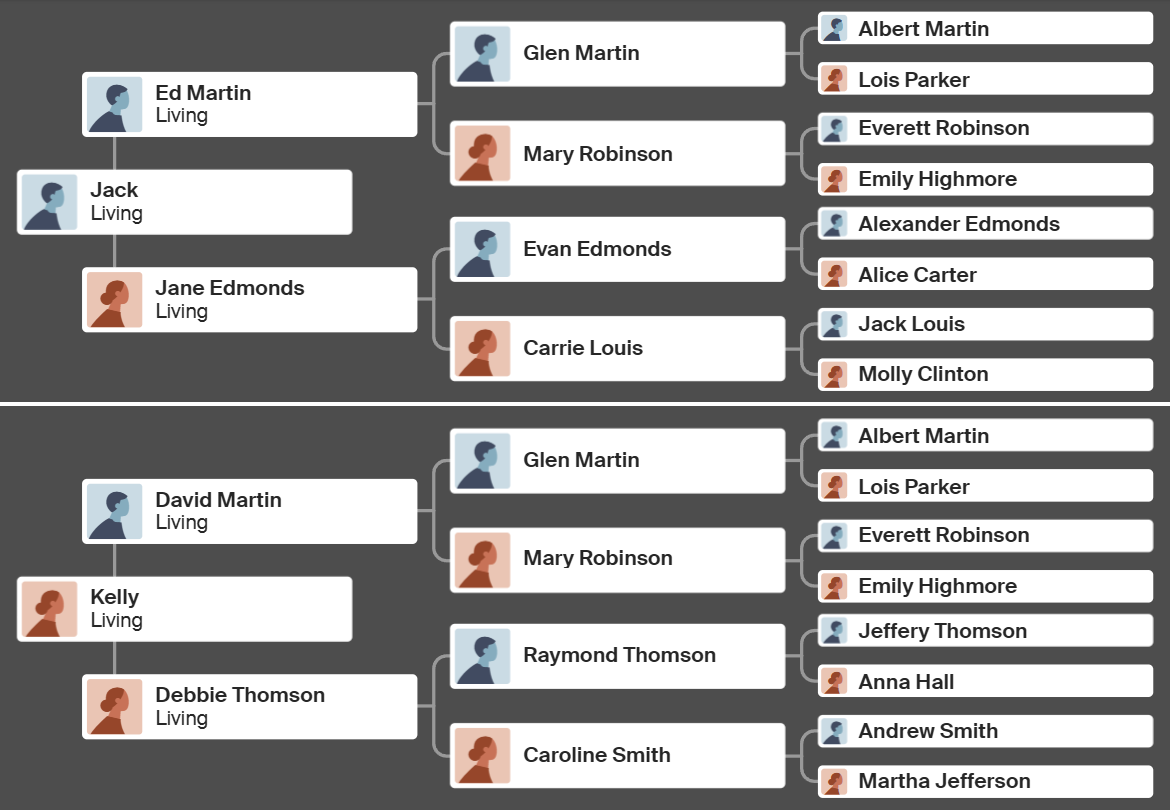
In the two trees shown above, how are Jack and Kelly related? Simply look for the closest common ancestors and their location in the tree. Here we can see both of them are related to Glen Martin and Mary Robinson. They have two grandparents in common. Therefore, they are first cousins. Remember, if the closest common ancestors are in the grandparent range (like we see here), the relationship will be some kind of first cousin. If they are in the great-grandparent range, you will be second cousins. If the closest relationship is a generation further, you are third cousins, etc. Now, let's make a small change to one of the trees. Explain the relationship if the trees looked like this...
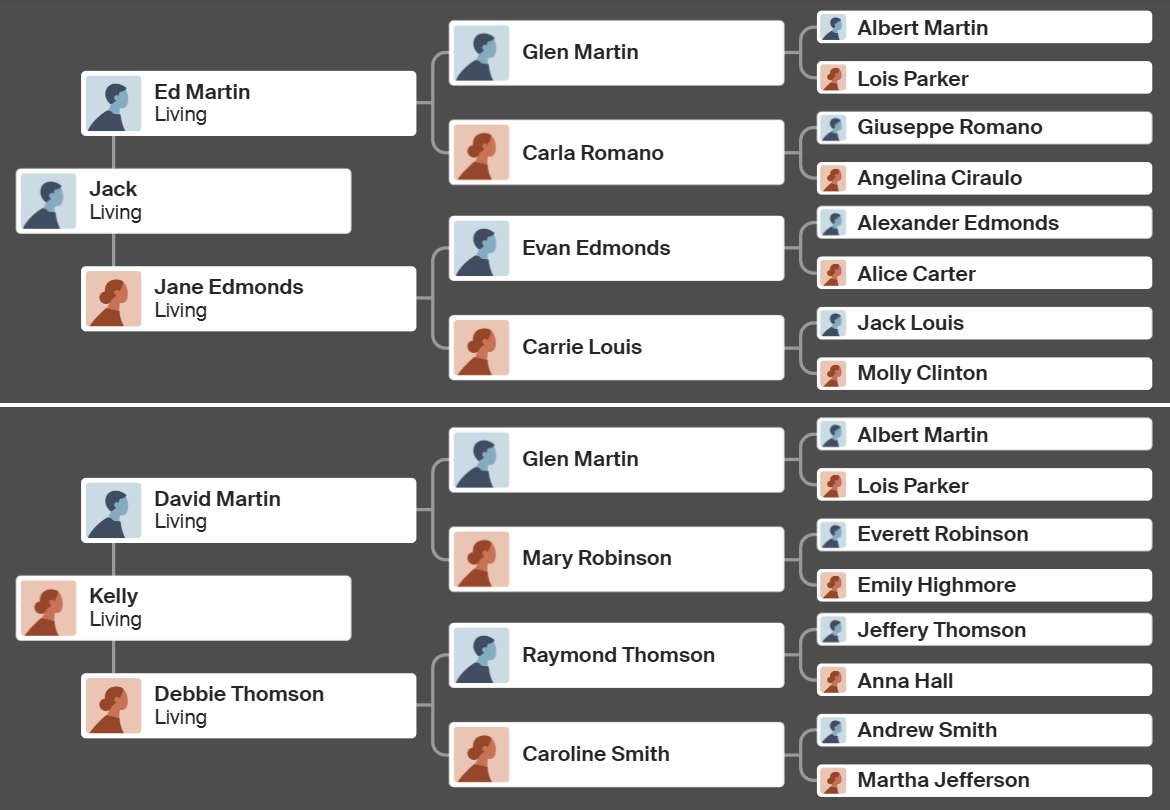
Did you spot the change I made? What if Jack's grandmother was a different woman? Now, the closest common ancestor is a SINGLE person. Kelly and Jack have only ONE closest common ancestor. When this occurs, you will have some kind of HALF relationship. That's important to understand. If your closest common ancestors are a pair of people (like a husband and wife), you will have a FULL relationship. So, what is the relationship shown here? Half first cousins. The closest common ancestor is a single grandparent. The same is true for any generation. If you have one parent in common with someone, you have a half sibling. If you have one great-grandparent in common with someone, you have a half second cousin. Now let's get into some trees that involve people from different generations.
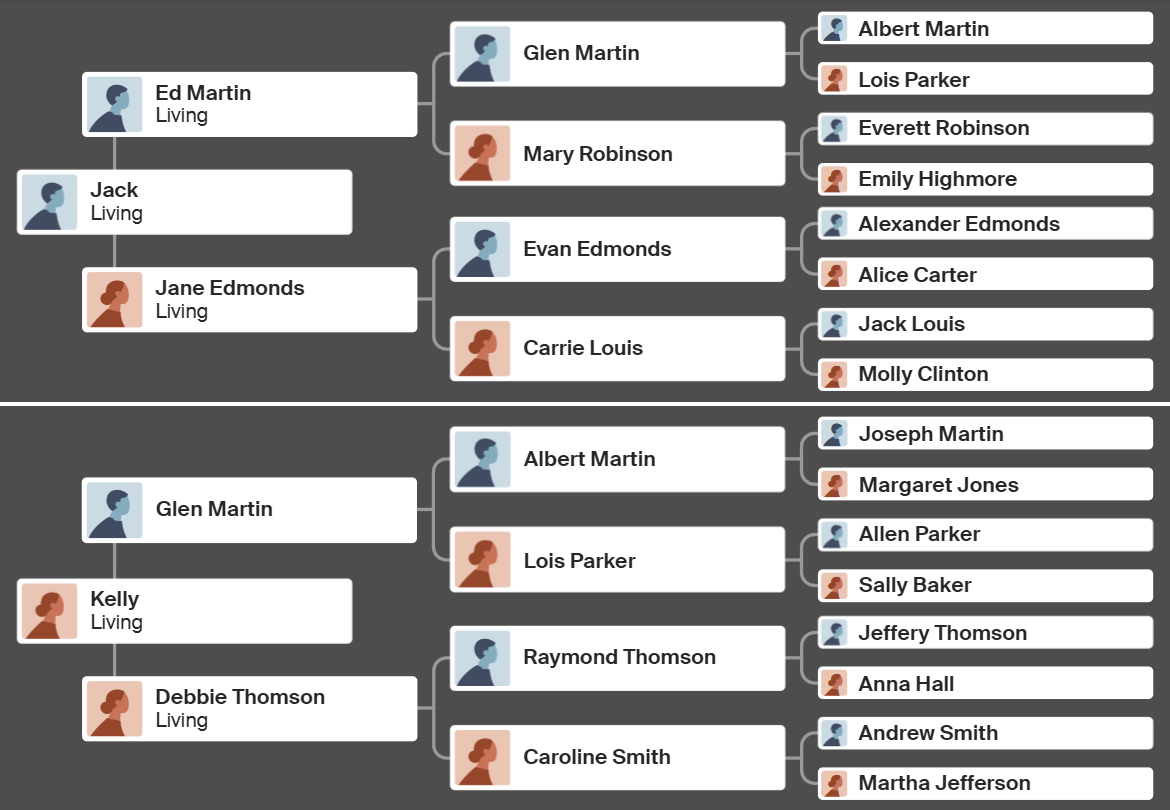
The tree above looks a little different now. Kelly is now a generation older than Jack. Glen is her father, and Glen is Jack's grandfather. So, again, the closest common ancestor is a single person, not a couple. So, this is going to be some kind of half relationship. Kelly and Ed now have the same father, so they are half siblings. Jack is Kelly's half brother's child. Therefore, Jack is Kelly's HALF NEPHEW and Kelly is Jack's HALF AUNT in this tree. Let's look at another one...
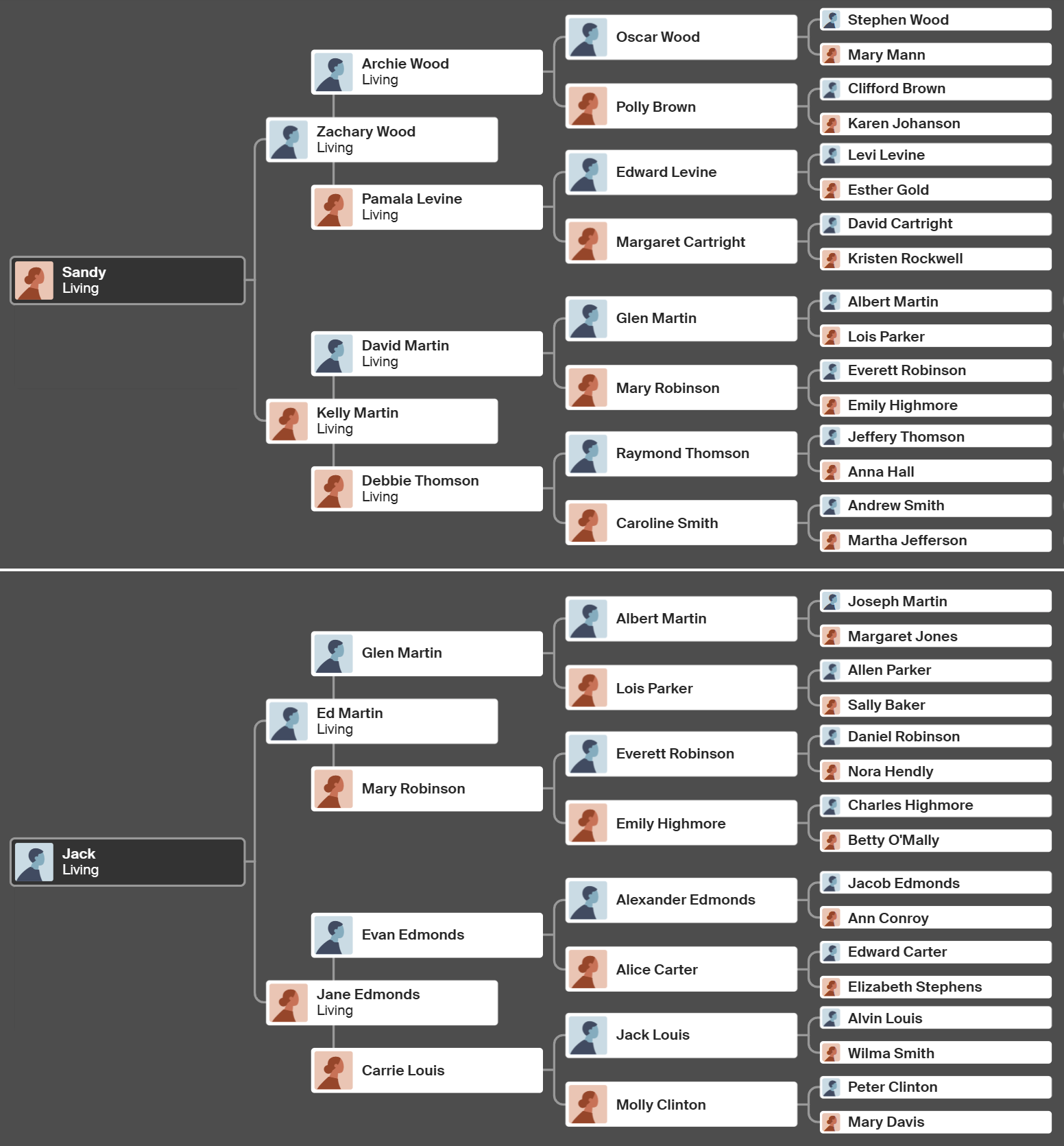
In the example above, we see Sandy with Glen and Mary as her great-grandparents. Jack has the same people as his grandparents. Here's the best way to think about this... Look at the relationship from the point of view of the person who is closest to the common ancestors. In this case, Jack. So we are dealing with Jack's GRANDPARENTS. As I mentioned earlier, when the closest common ancestors are in the grandparent range, the relationship is going to be some kind of first cousin. When two people are one generation apart, they are ONCE REMOVED. There's your answer, first cousins once removed.
These examples are about as easy as it gets, and you'll likely see these relationships if you examine lots of trees. If you've read some of my previous posts, then you know things can get much more unusual. Here's something I've seen several times. More often than you might expect. I've made a change to the trees shown above. Find the change and explain what's going on here...
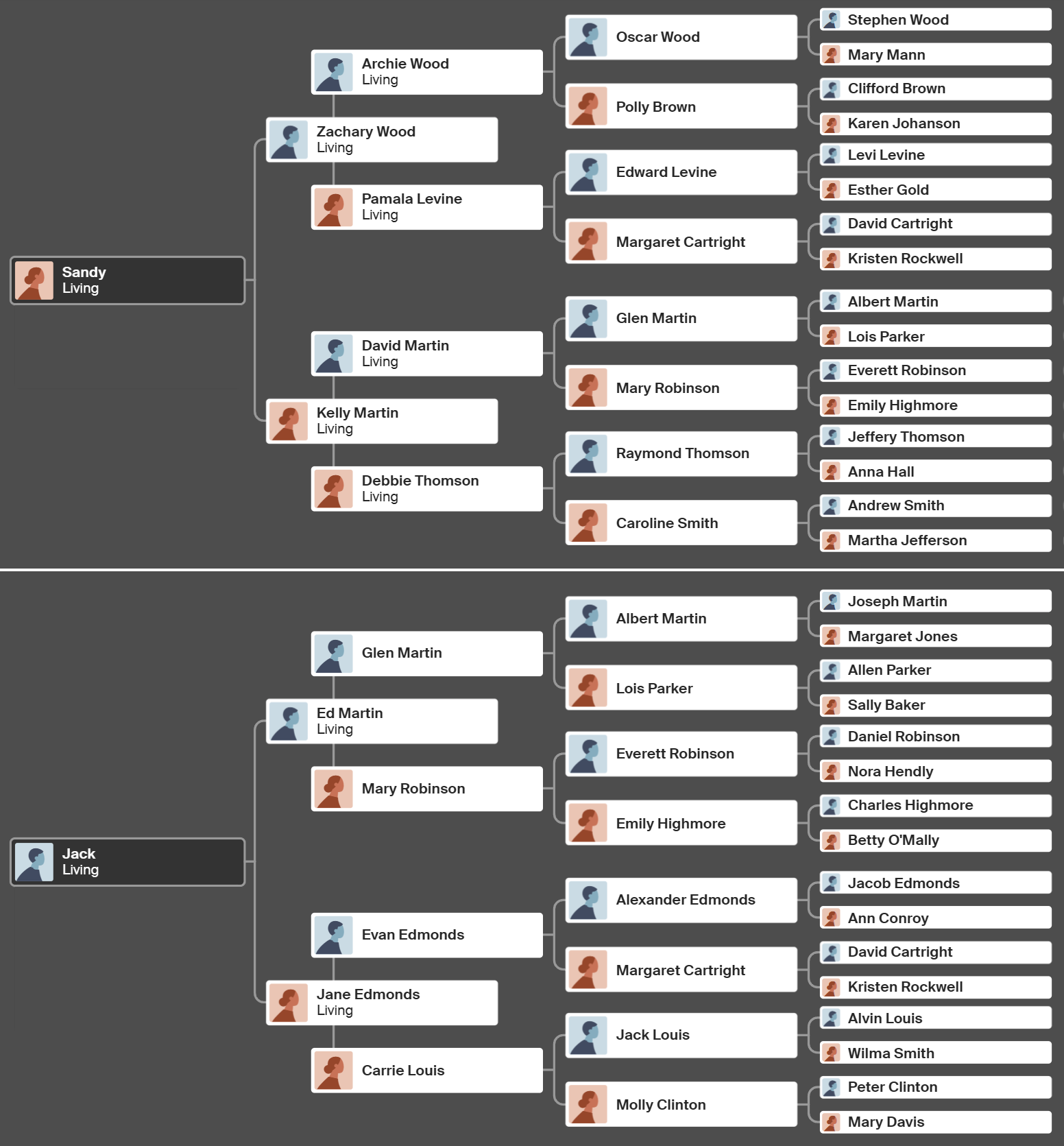
When using a website like Ancestry.com, it now divides up your matches by parent. I'm finding that most people also end up with a BOTH category. This means people may have DNA matches who match to both sides of their family. You might be thinking, "How can that be possible unless the person is a sibling or a niece/nephew." Or, you might think, "Are my parents related?" No, not necessarily. It's possible a DNA match could be matching you on multiple lines of your tree. They might have a close relationship on one side, and some very distant relationship on the other side. It's actually not that uncommon. Maybe they will even have a close relationship on both sides.
Did you find the change in the trees above? Sandy and Jack are still first cousins once removed. Nothing changed there. Notice I now show Jack related to Margaret Cartright. The same Margaret Cartright related to Sandy. So, now Jack and Sandy also have one great-grandparent in common. They now have an additional relationship to each other. They are half second cousins AND first cousins once removed. You might be thinking "They are in different generations. They are once removed. How can they be in the same generation too?" Well, it can happen. We don't know the ages of the people here. Maybe Mary Cartright married one man her own age, and another man who was much older. Jack and Sandy are in different generations on one side of the family, and in the same generation on the other side. It's totally possible.
What about centimorgans? When you're looking at DNA matches and you've determined relationships by looking at trees, you can then confirm it if you have the DNA data. If someone is your first cousin once removed, and the trees show that, look at the numbers. That relationship is often in the 400-500cM range (although it can vary). If the trees and the numbers match up, you're on your way to confirming the relationships. If things don't add up, it can lead you to discovering something is wrong with a tree.
Here's an example of a possible problem. Based on the two trees above, I'd expect a high centimorgan number. Remember, Jack and Sandy have two relationships. You can basically add up the DNA you'd expect from both those relationships. What if they had a DNA match of only 100cM? And what if the website didn't tell you they are related on BOTH sides of their families? That would lead me to believe something is very wrong. Take a moment and think about it before reading the next paragraph. I can make a pretty good assumption of what's wrong based on that number alone. What assumption would you make?

Sandy and Jack are supposed to be first cousins once removed, AND half second cousins. As we know, DNA levels can vary, but they can only vary so much. I would expect those two relationships combined would probably add up to 500cM, or something like that. Maybe more, maybe less, but you're NOT going to have a first cousin once removed with only 100cM in common. It's out of range. A half second cousin would likely be in the 100cM range however. This would lead me to guess that Jack or Sandy is not really related to Glen Martin and Mary Robinson. It could mean a few different things. Ed Martin may not know who his real parents were. Jack's father may not really be Ed. Kelly's father may not really be David. If any of those things were true, the first cousin once removed relationship would be removed from the equation and we would only be getting the 100cM from the half second cousin relationship. It would make sense. At this point you would use shared matching to find out who everyone is really matching to and maybe you could figure it out.
I hope this look at family trees will help you understand their importance. If you can visualize the relationships in family trees, then confirm them with DNA, you're on your way to solving a mystery and gaining a better understanding of how people are related.
Next, find out what percentage of people don't know who their real father is.

